By
Celos - Jacob Gade (1869-1963), the unknown creator of “Jealousy” (Jalousie)

he melody was already famous a quarter of a century before but I came to know it in the 50s. It was constantly repeated on the radio because at home it was always turned on. My parents praised that singer’s capabilities. It was an American who emphasized certain words and all of a sudden he used to increase the volume of his voice to later sing more softly. They enjoyed that. Daily every now and then that voice sprang up. One evening Daddy turned up with that record and Mom was so happy that ran to the turntable to play it. Many years later, browsing the old lacquer discs, I found it. It was in a perfect state with its blue label of the Columbia company (C 20001 A. “Jealousy”, tango by Vera Bloom and Jacob Gade. Frankie Laine sings with orchestra accompaniment. On piano Carl Fischer). On the other side, a bolero written by Jerome: “Flamenco”.
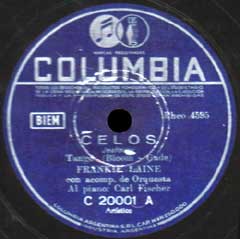 Years later when I was an adult and a tango fan, I asked to myself who Gade, the composer of that beautiful music, was. So I came to learn that he was born in Denmark, but nothing more.
Years later when I was an adult and a tango fan, I asked to myself who Gade, the composer of that beautiful music, was. So I came to learn that he was born in Denmark, but nothing more.
In the early 90s, I phoned the Danish embassy. Vaguely, they remembered that there was a folder with some notes about that gentleman but someone had taken it. When I tried to insist on that, years later, it was the embassy which was no longer there, only the consulate remained but also it was to no avail. Today, thanks to Internet —something which I still don’t master— and to my son, I succeeded to make a deeper research.
Jacob Thune Hansen Gade was born in Vlejel, Denmark on November 29, 1869 and died on February 20, 1963. He belonged to a family of musicians. His grandfather and his father used to go around the nearby villages to play at all kinds of parties. And it was natural that, since early age, he as well began to play and was another member of the musical group.
He was 9 when he made his debut as trumpeter. He might have been an attraction because only a year later he was invited to Copenhagen to become a soloist in the orchestra of the Tivoli Garden, a famous amusement park. It was only at age 12 when he began to study violin, firstly with his father and later with teachers of greater knowledge. Soon he evidenced his ambition, he wanted to be recognized and for that he decided to move to the capital.
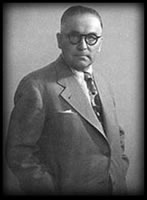 He began to compose country music, polkas and similar rhythms. With a scarce capital he left hurrying up his fate. He dreamed of being an orchestra conductor, and of writing waltzes, by then he was convinced that it was the best music in the world. He had a hard time, at night, he used to sleep at the entrance of buildings, at the hall near the stairs.
He began to compose country music, polkas and similar rhythms. With a scarce capital he left hurrying up his fate. He dreamed of being an orchestra conductor, and of writing waltzes, by then he was convinced that it was the best music in the world. He had a hard time, at night, he used to sleep at the entrance of buildings, at the hall near the stairs.
He started to work at small cafeterias and, about two years later, when he was only 18, he began to be connected with people who summoned him to play at an operetta in Frederiksberg, the night center of entertainment at that time.
A prolific composer, in 1900, for the first time a toast song of his was published titled “Der er sollys i modne druer” (The sunshine on the ripe grapes), with lyrics by his finder, Lorry Feilberg. It turned out a very popular song and, among others, it was sung by Elna From, a theater actress ten years older than he, who was his first love. Despite they never married, with her he had 3 children. They separated in 1906 and two years later, in Christiania, then capital of Norway, he married another actress: Mimi Mikkelsen, with whom he lived until she died in 1951.
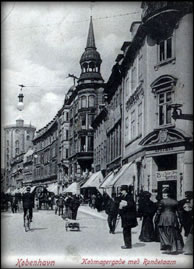 He joined several orchestras up to 1903 when he already led his own. He didn't change his orientation, he was creator and diffuser of danceable music. In 1909, the recognition he achieved by his work made him be hired by the famous Hotel Bristol, located in front of the main plaza of Copenhagen. In order enhance his musical knowledge he turned to maestro Max Schlüler, an important concert player. Gade was already 30 and was too old to become a concert instrumentalist of classical music. Some time before, because of the same reason he had not been accepted in the Royal Conservatory of Danish Music.
He joined several orchestras up to 1903 when he already led his own. He didn't change his orientation, he was creator and diffuser of danceable music. In 1909, the recognition he achieved by his work made him be hired by the famous Hotel Bristol, located in front of the main plaza of Copenhagen. In order enhance his musical knowledge he turned to maestro Max Schlüler, an important concert player. Gade was already 30 and was too old to become a concert instrumentalist of classical music. Some time before, because of the same reason he had not been accepted in the Royal Conservatory of Danish Music.
In 1914 he began to lead orchestras that played at theaters and as well at the most important cinema theaters as accompaniment to silent films. At the same time he performed a series of concerts as soloist including a Paganini's composition. As composer he was in a period when he wrote waltzes with a title in French. He adopted several pseudonyms like Maurice Ribot, Leon Bonnard, James Wellington, Fred Marshall and Jascha Tjenko. He used to say that they made him widely known and provided him with an international touch. The principal paper of the city mentioned him as the king of waltz. His juvenile dream was coming true.
In 1919 he traveled to New York, joined orchestras that played at cinema theaters, and put together aggregations that included up to 80 members and, soon he had another satisfaction, he was chosen in a contest to join the Philharmonic Orchestra of New York. For two years he only devoted to playing classical music.
He returned to his country to conduct the orchestra of the Palads Cinema theater and to compose and arrange music to be played during the projection of movies. By that time he composed “Jalousie”. They say that its title had inspired the melody. He was on leave in Christiania, near a windmill far from the city, when he read on a paper that a man had murdered his wife because of jealousy.
His golden period lasted until 1929 when sound films arrived. But it scarcely affected him. In 1931 he opened the National Scala theater, and there he continued to play entertainment music for dancing. His career as orchestra leader and player before public audiences ended by his own decision.
His tzigane tango “Jalousie” was a worldwide hit. Performed for the first time on Monday, September 14, 1925, on the premiere of the American movie Don Q. Son of Zorro, starring Douglas Fairbanks and Mary Astor, it placed Denmark in the world map of music. His royalties as composer were so ample that in the 70s it was estimated that the song was played, at least, once every minute on some radio of the planet.
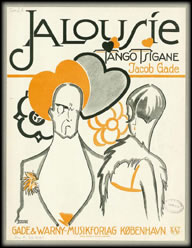 After “Jalousie” he devoted solely to musical composition, retired and based in a country house. There, among others, were born “Rhapsodietta” and another tango “Romanesca” which were published in Copenhagen and in Paris. He returned to the United States of America in 1939 where they offered to publish his whole output.
After “Jalousie” he devoted solely to musical composition, retired and based in a country house. There, among others, were born “Rhapsodietta” and another tango “Romanesca” which were published in Copenhagen and in Paris. He returned to the United States of America in 1939 where they offered to publish his whole output.
On April 8, 1940 he returned to his country. The following day the nazis invaded Denmark. He endured it by settling on the Fiskerleje island where he continued composing. There a successful waltz was born: “Capricious”. Also other tangos: “El matador”, “Tango charmeuse”, “Lille Mary Anne”, “Laila” and “Tango Glamour”.
“Jalousie” was born as an instrumental, but later in every country a lyric was written, according to their taste and commercial preference. This is the case of the above mentioned Vera Bloom for the previously cited Frankie Laine. In Finland a lyric written by Kuliervo is known. In Great Britain, the then famous orchestra led by Gerald Bright presented his vocalist Monterrey (his true name was Montgomery) singing a lyric by E. Way and so appeared many others of the kind.
In our country its instrumental form was always respected. We highlightthe renditions of the Sexteto Mayor; Nito Farace's who made an original delicate arrangement featuring the soloist Simón Bajour on violin; Osvaldo Requena's with Fernando Suárez Paz on violin; Francisco Lomuto's and Florindo Sassone's which has a good tango flavor but the violin is hardly heard. The piece possesses beauty because of its violin solos, without them the number is deprived of its charm.
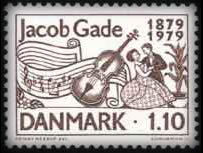 The boom of “Jalousie” stirred up a legal conflict with the Danish publishing house Wilhelm Hansen to which Gade had granted the royalties of all the pieces he would compose until a certain date. The omposer did not stick to what was agreed and published “Jalousie” by his own publishing house, Gade & Warny, thinking that the contract had expired, on the same day of the above mentioned premiere. The issue was solved after Gade yielded a part of his royalties.
The boom of “Jalousie” stirred up a legal conflict with the Danish publishing house Wilhelm Hansen to which Gade had granted the royalties of all the pieces he would compose until a certain date. The omposer did not stick to what was agreed and published “Jalousie” by his own publishing house, Gade & Warny, thinking that the contract had expired, on the same day of the above mentioned premiere. The issue was solved after Gade yielded a part of his royalties.
The number was included totally or partially in over 100 movies, in numerous television series and on all new ways of playing back since records appeared.
When he drew up his will in 1956, he included his wish that all his estate and future royalties were granted to a foundation that had to be created under his name to sponsor young talented musicians. Explaining that reason, he said: «I still remember the financial and educational difficulties I had when I was young, when I arrived in Copenhagen with the purpose of making a living with music».
With his will he opened a bank account with the deposit of 100.000 kroner (crowns). In 1993 the publishing house founded by Gade sued Hansen's for the huge figures that the latter collected as royalties from “Jalousie”, but the court passed judgment against the former. Agreements had to be respected.
Every year the foundation holds a contest for young violinists in Gade's hometown. On November 8, 1970 a postage stamp commemorating the centenary of his birth was issued.
There is a peculiar arrangement of “Jealousy” for a woodwind quintet which was premiered on the celebration of the twentieth anniversary of the accession to the throne of the queen Margaret of Denmark, in the Elsinore Castle in June 1992.
In 1998 Dacapo Recordings published a record with a part of his works —some unpublished—, performed by the Odense Symphonic Orchestra conducted by Mathias Aeschbacher featuring the soloist Bjarne Hansen on violin. Critics commented: «It is incredible that an unknown and so good music has been displayed because of the popularity of “Jealousy”».
The authors of this article thank pastor Andrés R. Albertsen for the translations of the Danish texts consulted.